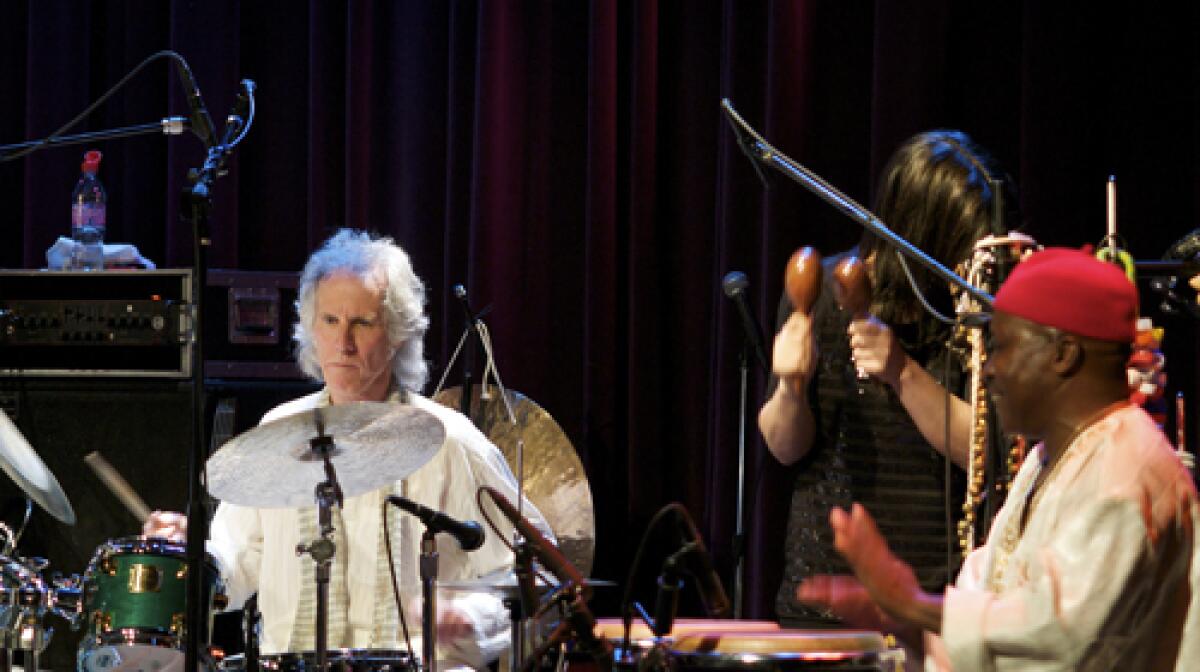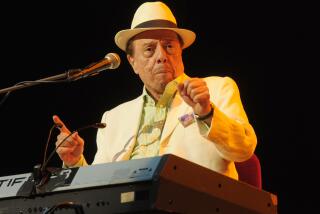John Densmore’s jazz education

THE GREAT jazz drummer Elvin Jones carried on a constant musical conversation with John Coltrane. It inspired me to have that kind of dialogue with Jim Morrison. Not that I was in Elvin’s league, but his courage gave me the “huevos” to stop the steady rhythm on the Doors’ “When the Music’s Over,” and just jab at my kit during Jim’s rap about “What have they done to the Earth, what have they done to our fair sister, rip her and bit her, stuck her with knives in the side of the dawn, and dragged her down.”
As a teenager, I saw Elvin play many times at these “sacred gin joints” (jazz clubs) in Los Angeles. I was too young to make the Central Avenue scene, but I knew it was much more than a major thoroughfare.
On an off night from the Orbit, a Santa Monica bar gig I got with my very lame fake ID from Tijuana, I stumbled into the Renaissance Club on the Sunset Strip, where Lenny Bruce had performed. It was my first time in a jazz club, and I was ushered to a table in the back behind a pole. I was one of very few white people in the place, and the Renaissance Club was intimidatingly cool. It had an attitude. I hadn’t cultivated one yet.
Pretty soon I was hitting all the great haunts: The Lighthouse, the Bit, the Parisian Room and Melody Lane down on Adams Boulevard. Some teenagers were dragged to church by their parents to get a dose of religion. . . . I found it with jazz.
This music has brought me back to these clubs, only this time I’m on stage! It is with great humility that I step onto the same stages that my early mentors commanded. Coltrane, Miles Davis, Dizzy Gillespie, Art Blakey, Oscar Peterson. There probably isn’t a jazz musician you could name that I haven’t seen play live.
The first time I saw Elvin Jones was in 1963 at Shelly’s Manne-Hole, the jazz club in Hollywood. The doorman knew I was underage but let me pass because of the addiction to sound he could see in my eyes. Jones sat behind one of the greatest jazz quartets in the history of the art form, and he did it with a huge grin. The Beatles hadn’t hit yet, and he was my muse.
Between sets I went to the bathroom, just because I knew it was across from the dressing room. Hearing voices and laughter, I occupied myself washing my hands, until I heard the voices drift out into the hallway. I spun around and, wiping my hands on my pants, turned the knob. John Coltrane was standing right in front of me. I quickly shunned eye contact. I noticed that everyone sort of quieted down when he passed. I then looked at Elvin’s face, and he smiled at me!
Coltrane and Miles seemed to be the culmination of years of evolution from be-bop to cool to free form. They were “out there,” searching for unknowns, playing in the cracks between the chord structure. It was a kind of raw spiritual anarchy . . . just the food for a hungry teenager. Besides, my parents thought it sounded “like someone stepping on a cat.” That was cool with me.
Paying homage
IN THE ‘90s, it was the old Catalina’s (on Cahuenga) where I mustered up the courage to go backstage and introduce myself to Elvin Jones. In a piece for the Utne Reader, I had described him as “blazing a new trail for all us timekeepers. He was the first to free up the job of clockwork, improvising continually, but never sacrificing a strong sense of pulse.”
I’d brought my autobiography, “Riders on the Storm,” as an offering and quickly said that “in here, I wrote that ‘you gave me my hands.’ ” My worry about criticism from a practitioner of the “higher art” was quickly defused when I realized he didn’t even know who the Doors were!
Elvin was extremely gracious, and over the years we became friends, me carrying his cymbal bag to his car the last few years of his life. Now playing these youthful haunts feels like “completion” because I’ve come full circle.
The “press roll” in the Doors’ “Wild Child” is from sitting right next to Art Blakey at the Manne-Hole. The groove on “The End” is influenced by seeing Chico Hamilton down at Howard Rumsey’s Lighthouse at the Sunday afternoon jazz sessions. The free-form drumming behind Jim’s poetry is watching Elvin and Coltrane battle it out in “Chasin’ the Trane.”
Each time I humbly mount the pulpit to give the sermon with the group I founded with reedman Art Ellis, a quartet fuel-injected by two master African drummers, I hope that the knowledge I garnered from the “early years” will help me. This global village of musicians certainly does. Both genders are present here (Cristina Berio on percussion), and several shades of color (Aziz Faye and Marcel Adjibi from Africa).
It was 45 years ago that I mouthed off about being a “jazz” drummer (even before the Doors). Tribaljazz has finally given me the courage to put my sticks where my mouth has been.
John Densmore is an author, essayist and the former drummer of the Doors. His quartet Tribaljazz is scheduled to perform at 2:30 p.m. today as a part of the UCLA Jazz Fest.
More to Read
Sign up for Essential California
The most important California stories and recommendations in your inbox every morning.
You may occasionally receive promotional content from the Los Angeles Times.










